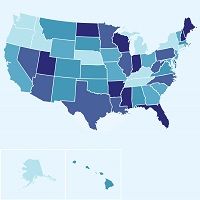IBS Care Varies Widely Across the Country
Study results show significant regional variations in the types of procedures and tests administered and the number of prescriptions written for patients with irritable bowel syndrome (IBS), as well as in the number of emergency department visits and hospital admissions.

It has been known for some time now that there are regional variations in the type and quality of care provided to patients in this country. Studies have shown that a variety of factors can determine whether a patient receives a certain test or procedure, including where they seek care, socioeconomic status, insurance status, type of facility in which they are treated, and others.
So it’s not surprising that to see similar variations in care across the country for a heterogeneous disorder like IBS that is characterized by non-specific symptoms, overlapping upper and lower abdominal symptoms, and co-existing somatic and psychological disorders.
According to study results presented at the American College of Gastroenterology 2014 Annual Scientific Meeting and Postgraduate Course, “these challenges in diagnosing and treating IBS increase the likelihood that care of IBS patients varies across practice. To determine the extent of regional variations in care received by IBS patients, researchers conducted a retrospective cohort study using medical and pharmacy claims from a large US commercial claims database.
For the study, investigators looked at claims data from 2001-2012 for adult patients (age 18 years and older at time of first IBS diagnosis who had at least one year of continuous health care plan enrollment before and after the date of first IBS diagnosis, and who had 2 or more diagnoses of IBS recorded on separate dates.
The study period was “defined as the 2-year period surrounding the first IBS diagnosis recorded in the database,” with the index date defined as the date of first IBS diagnosis. A total of 203,281 IBS patients met the criteria. The mean age of participants was 50 years and more than three-quarters (77%) of participants were female.
Investigators used claims data to track several categories of health care resource utilization (HRU), including IBS diagnostic tests (colonoscopy, CT scan, anorectal function testing, ultrasound). They also tracked the number of patients who received 3 or more distinct IBS tests or procedures, pharmacy prescriptions for diarrhea and constipation treatments, and GI-related emergency department visits, hospital admissions, and visits to GI specialists.
The authors compared HRU in each state with HRU in the rest of the US using generalized linear regression models, and reported the results as incidence rate ratios (IRRs) adjusted for potential confounding factors.
They reported that 45% of patients had received colonoscopy, 35% received CT scans, and 35% received ultrasounds. More than one-third (36%) of patients had receive 3 or more IBS procedures or diagnostic tests during the study period. Only about one-third of patients received a prescription for diarrhea or constipation treatment (33%), and half of all patients had been referred to a GI specialist.
Patients in Minnesota and Maine were most likely to receive anorectal function testing, while patients Delaware and Maryland were the least likely. Colonoscopy incidence was highest in Delaware and lowest in Vermont and California.
Several states in the Midwest and West had the highest rates for CT scans (Missouri, Kentucky, Montana, West Virginia, Minnesota, Utah, Tennessee, and Ohio), while California had the lowest incidence compared to the rest of the country. Patients in New Mexico were most likely to receive an ultrasound and patients in Hawaii were the least likely.
Patients in Delaware, Florida, and West Virginia were the most likely to have received 3 or more IBS diagnostic tests and procedures, while patients in California and Oregon were the least likely. Medical prescriptions for diarrhea and constipation also showed similar variation, with patients in Hawaii, Louisiana, and Alabama being the most likely to receive a prescription, and patients in North Dakota the least likely.
The study results also showed wide variation in the likelihood of patients visiting the emergency department or being admitted to the hospital for GI-related complaints. Similarly, there were significant differences in the incidence of GI specialist visits, with Georgia having the highest and several states in different regions of the country having the lowest.
In their summary of these results, the authors wrote that the substantial variations in IBS care across the US “may occur for several reasons, including differences in medical practice across the nation, existence of certain medical or academic care providers in a region, or accessibility of care providers and medical services.” Further study is needed to identify the factors that are responsible for these differences.